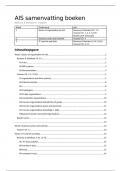Samenvatting
Samenvatting voor het vak Accounting Information Systems (boeken: Romney & Steinbart en Vaassen)
- Instelling
- Rijksuniversiteit Groningen (RuG)
Dit is een samenvatting die ik gebruikt heb voor het vak Accounting Information Systems. De samenvatting bevat 2 boeken (Accounting information systems van Romney and Steinbart, en Accounting information systems and internal control van Vaassen). Het is een duidelijk overzicht waar per stuk tekst v...
[Meer zien]




